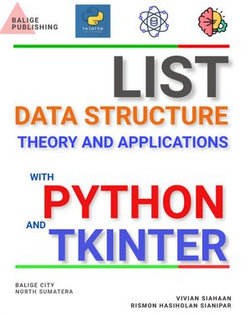In the rapidly evolving world of technology, understanding foundational concepts like data structures, specifically lists, and their manipulation is essential. This book aims to delve deep into the practicalities of using lists in Python, a versatile and widely-used programming language known for its ease of use and powerful libraries. Coupled with this, the book explores the graphical user interface library, Tkinter, providing a comprehensive guide on how to make Python's capabilities more interactive and user-friendly.
The significance of lists in programming cannot be overstated. They are among the most basic and crucial data structures in computer science, essential for storing sequences of data that are dynamically modifiable. In Python, lists are used extensively across simple applications to high-end data processing tasks. This book will start by exploring the anatomy of lists in Python, covering their creation, manipulation, and application in various real-world scenarios.
Following the understanding of lists, the discussion will transition to operations on lists. Operations like appending, slicing, sorting, and more are pivotal in handling data efficiently. Through practical examples and detailed explanation, readers will learn how these operations are implemented in Python and how they can be used to solve common programming problems.
Moreover, the power of list comprehensions, a distinctive feature of Python that allows for concise and efficient manipulation of lists, will be thoroughly discussed. This feature not only simplifies code but also enhances its readability and efficiency, making Python an appealing choice for developers.
However, theoretical knowledge of these operations and their syntax only scratches the surface of their potential. To bridge the gap between theory and practical application, this book incorporates interactive examples using Tkinter, Python’s standard GUI library. Tkinter allows programmers to create graphical interfaces, making software applications accessible to a broader audience, including those who might not be comfortable with command-line interfaces.
Integrating list operations into a GUI can significantly enhance the functionality and user-friendliness of applications. For instance, users can interact with the data more intuitively, perform operations in real-time, and see the results immediately, which is crucial for learning and debugging.
The chapters dedicated to Tkinter will guide readers through setting up their first GUI applications. Starting from basic windows and widgets, the discussion will evolve to include how list operations can be integrated into these interfaces. Whether it's displaying a list, updating it based on user input, or sorting and filtering data based on user commands, the book will cover a wide range of use cases.
One of the core strengths of combining list operations with Tkinter is in educational software, where interactive tools can significantly enhance the learning experience. By allowing students to manipulate data structures in real-time, they can see the immediate impact of their actions, thereby deepening their understanding of the subject matter.
Furthermore, this approach has applications in professional software development, where developers need to build applications that are not only functional but also intuitive and responsive. The book will explore several project ideas and real-world applications, showing how the concepts discussed can be used to build meaningful and efficient software.
Beyond educational and professional environments, this integration finds relevance in data analysis and visualization tasks. Analysts often need to manipulate large datasets and visualize their results effectively. Here, Python’s list operations and Tkinter’s graphical capabilities come together to offer powerful tools for data manipulation and display.
In addition to practical applications, the book also addresses best practices and common pitfalls in both list manipulation and GUI development. Understanding these will help readers avoid common errors and improve the performance of their code.
As technology continues to advance, the importance of understanding foundational programming skills and integrating them into user-friendly applications cannot be overstated. This book is designed not just to teach but also to inspire its readers to explore the possibilities of Python and Tkinter, encouraging them to develop applications that are powerful, efficient, and user-centric.
In conclusion, this book serves as a comprehensive guide for anyone looking to deepen their understanding of Python’s list operations and GUI development using Tkinter. By the end of this book, readers will not only be proficient in these areas but will also be equipped to apply these skills in practical, innovative, and effective ways..



Share This eBook: